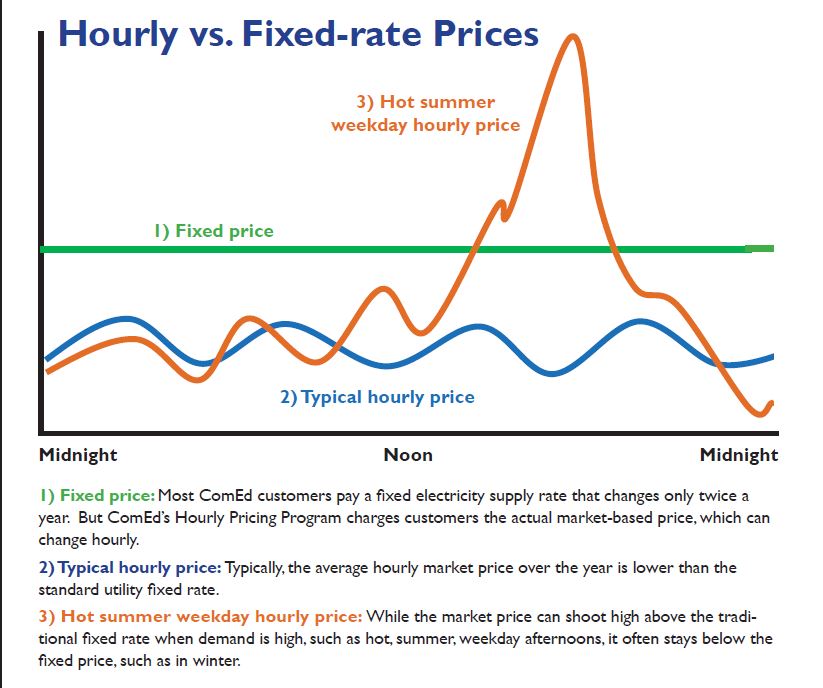ComEd Hourly Pricing Program
What is the Hourly Pricing program?
Illinois was the first state in the country to launch a statewide residential Hourly Pricing program. It offers ComEd customers a different way to pay for electricity, charging them a supply rate that can change on an hourly basis, instead of the standard price that stays the same 24/7.
Since the program began, Hourly Pricing has saved participants an average of about 15 percent on the supply portion of their power bills, although savings aren’t guaranteed. An ongoing analysis of energy-usage data by CUB and Environmental Defense Fund (EDF) has found that most ComEd customers could save money under the program, with even better results for those willing and able to change how and when they use major appliances.
The program also helps reduce demand for expensive and pollution-causing power plants, and it can help prevent power outages by reducing stress on the electricity system during “peak” times, when power usage and prices are at their highest.
Visit the ComEd website or call 1-888-202-7787 to learn more. The program is managed by Elevate Energy, a Chicago-based nonprofit organization dedicated to helping people save energy and money.
How does it work?
ComEd traditionally charges residential customers a fixed electric rate that changes only twice a year. But Hourly Pricing customers pay a market price that can change every hour.
This price variability may sound scary, but for most of the year the hourly rate is lower than ComEd’s default flat rate.

How can I save money in the program?
The Hourly Pricing program gives you a number of tools to help you adjust your electricity-usage habits. If the price is expected to climb above a certain predetermined level (14 cents per kWh), you will get a call or e-mail the night before, suggesting you change your power usage the next day to avoid high-price times.
Plan your energy usage by checking the “dayahead” prices—a highly accurate estimate of the approaching day’s hourly prices—either by phone or online. The program also provides tips on cutting your energy costs and personalized online account information to track whether or not you are saving under the program.
Is Hourly Pricing right for me?
Your chances of saving on Hourly Pricing are good if you:
1) Consistently have a monthly electric bill that is more than $50.
2) Heat your home with electricity.
3) Own an electric vehicle (EV). (In 2019, CUB’s research team published a paper that showed potential
electricity supply savings of more than 50 percent for EV owners who enroll in Hourly Pricing.)
Hourly Pricing is perfect for people who want to take more responsibility for their electricity usage and are
curious about how to cut their power bills by changing when they use their electricity.
The program may not be right for customers who need to use their dishwasher or air conditioning often
during peak-usage times, when the market price of power at that moment could be well beyond the regular
utility flat rate.
What are the program's requirements?
Hourly Pricing is available to residential customers who purchase their electric supply from ComEd. (If you are with an alternative electricity supplier, you have to switch back to ComEd before you can sign up for Hourly Pricing.)
You can leave Hourly Pricing at any time, but it’s a good idea to stay with the program for at least a year. Pricing patterns and your usage change with the seasons, so it’s best to evaluate the program after you have received 12 months of bills.
If you leave Hourly Pricing, you cannot rejoin the program for a period of 12 months following the termination.
How will my electric bill look different?
Most charges on your bill will remain the same. However, some line items in the supply section of your bill will differ from the standard fixed rate.
As with standard bills, your Hourly Pricing bill will include an Electricity Supply Charge, a Transmission Services Charge, and a Purchased Electricity Adjustment. However, the rates will differ from those on a standard fixed-rate bill.
Additionally, your Hourly Pricing will include separate line items for a Capacity Charge and the Miscellaneous Procurement Component Charge. But this doesn’t mean you’re paying extra charges. You still pay Capacity and Miscellaneous Procurement costs on standard bills, but they’re included in the Electricity Supply Charge. (Read our blog on how to figure what capacity charge you would pay under the Hourly Pricing program.)
Hourly Pricing customers can find an online breakdown of how much electricity they used and the rate they paid each hour over that period at HourlyPricing.ComEd.com.
ComEd had a free, optional program called Load Guard as a service to Hourly Pricing and AC Cycling participants, but the program was discontinued in March 2024.
Hourly Tips for Saving
Things you can do to save money and energy during expensive “peak” hours:
- Temporarily change your central air conditioner to a warmer temperature. (Take advantage of AC Cycling and Load Guard.) If you have a window air conditioner, turn it off or put it on a warmer setting.
- If you have an electric stove or oven, grill or enjoy a cool meal like a sandwich or salad.
- Use energy-heavy appliances like the dishwasher, washer and dryer, and basement dehumidifier in the morning or evening when prices are lower.
- If the summer heat gets to you, plan a trip to the beach or a pool during the peak hours. Or hang out in an air-conditioned public space, such as a movie theater, museum, shopping mall, or library.
For information about incentives to make efficiency investments, visit: CitizensUtilityBoard.org

